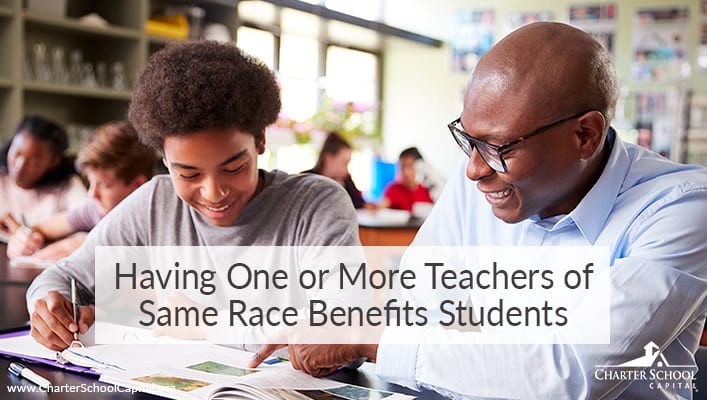Having One or More Teachers of Same Race Benefits Students
Editor’s Note: This article was originally published here on June 4, 2019 by the Thomas B. Fordham Institute. It looks at the evidence that shows how having teachers of the same race impacts a student’s educational career and makes a positive impact. It shares the disparities in teacher/student race-matches in traditional public schools and public charter schools.
We think it’s vital to keep tabs on the pulse of all things related to charter schools, including informational resources, and how to support school choice, charter school growth, and the advancement of the charter school movement as a whole. We hope you find this—and any other article we curate—both interesting and valuable.
Read on for more details.
Student-Teacher Race Match in Charter and Traditional Public Schools
There’s mounting evidence that, for children of color especially, having one or more teachers of the same race over the course of students’ educational careers seems to make a positive difference.
But to what extent, if any, do the benefits of having a same-race teacher vary by type of school?
Existing “race-match” studies fail to distinguish among the traditional district and charter school sectors. Knowing whether differences exist across school types could improve how we recruit and develop educators, as well as shed light on whether the success of urban charter schools is due in part to their greater success in recruiting a diverse teaching staff—an explanation that’s received short shrift in research and policy circles.
“Student-Teacher Race Match in Charter and Traditional Public Schools,” authored by Dr. Seth Gershenson of American University, uses student-level data for all public school students in North Carolina from grades three to five between 2006 and 2013. The analysis yielded five findings:
- Traditional public schools and charter schools serve the same proportion of black students, but charter schools have about 35 percent more black teachers.
- Black students in charter schools are about 50 percent more likely to have a black teacher than their traditional public school counterparts, but white students are equally likely to have a white teacher across the two sectors.
- Race-match effects are nearly twice as large in the charter school sector as in traditional public schools, though these differences are statistically insignificant, likely due to small sample sizes.
- In charter schools, race-match effects are twice as large for nonwhite as for white students, while no such difference exists in traditional public schools.
- Race-match effects are relatively constant across school locales, enrollments, and compositions.
Since the effects of having a same-race teacher appear stronger in charter schools than in the district sector—and stronger still for nonwhite students—it’s encouraging that the charter sector has more of these matches between black students and teachers, due largely to having more black teachers in the first place. This is clearly an overlooked dimension of charter effectiveness.
Moreover, traditional public schools might seek to emulate their charter school counterparts when it comes to boosting the number of teachers of color they hire, though there remains room for improving teacher diversity, not to mention academic achievement, in both sectors.
 Since the company’s inception in 2007, Charter School Capital has been committed to the success of charter schools. We help schools access, leverage, and sustain the resources charter schools need to thrive, allowing them to focus on what matters most – educating students. Our depth of experience working with charter school leaders and our knowledge of how to address charter school financial and operational needs have allowed us to provide over $1.8 billion in support of 600 charter schools that have educated over 1,027,000 students across the country. For more information on how we can support your charter school, contact us. We’d love to work with you!
Since the company’s inception in 2007, Charter School Capital has been committed to the success of charter schools. We help schools access, leverage, and sustain the resources charter schools need to thrive, allowing them to focus on what matters most – educating students. Our depth of experience working with charter school leaders and our knowledge of how to address charter school financial and operational needs have allowed us to provide over $1.8 billion in support of 600 charter schools that have educated over 1,027,000 students across the country. For more information on how we can support your charter school, contact us. We’d love to work with you!

